roof FIAT PUNTO EVO 2010 1.G Owners Manual
[x] Cancel search | Manufacturer: FIAT, Model Year: 2010, Model line: PUNTO EVO, Model: FIAT PUNTO EVO 2010 1.GPages: 270, PDF Size: 8.34 MB
Page 82 of 270
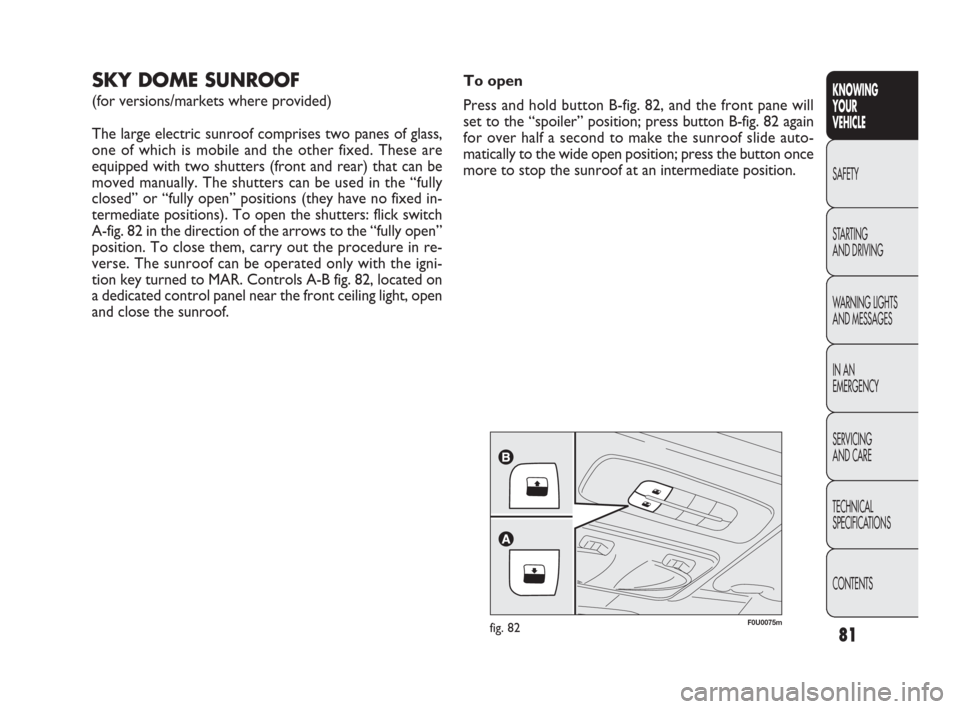
81
KNOWING
YOUR
VEHICLE
SAFETY
STARTING
AND DRIVING
WARNING LIGHTS
AND MESSAGES
IN AN
EMERGENCY
SERVICING
AND CARE
TECHNICAL
SPECIFICATIONS
CONTENTS
F0U0075mfig. 82
SKY DOME SUNROOF
(for versions/markets where provided)
The large electric sunroof comprises two panes of glass,
one of which is mobile and the other fixed. These are
equipped with two shutters (front and rear) that can be
moved manually. The shutters can be used in the “fully
closed” or “fully open” positions (they have no fixed in-
termediate positions). To open the shutters: flick switch
A-fig. 82 in the direction of the arrows to the “fully open”
position. To close them, carry out the procedure in re-
verse. The sunroof can be operated only with the igni-
tion key turned to MAR. Controls A-B fig. 82, located on
a dedicated control panel near the front ceiling light, open
and close the sunroof.To open
Press and hold button B-fig. 82, and the front pane will
set to the “spoiler” position; press button B-fig. 82 again
for over half a second to make the sunroof slide auto-
matically to the wide open position; press the button once
more to stop the sunroof at an intermediate position.
037-081 PUNTO FL EN 4ed 18-01-2010 12:23 Pagina 81
Page 83 of 270
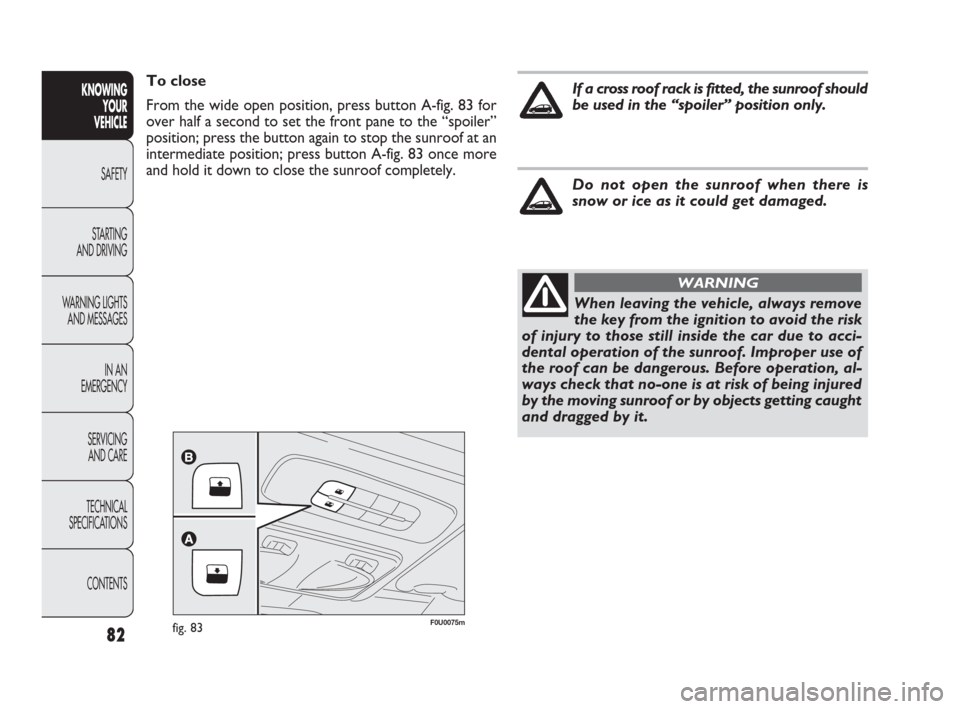
82
F0U0075mfig. 83
To close
From the wide open position, press button A-fig. 83 for
over half a second to set the front pane to the “spoiler”
position; press the button again to stop the sunroof at an
intermediate position; press button A-fig. 83 once more
and hold it down to close the sunroof completely.KNOWING
YOUR
VEHICLE
SAFETY
STARTING
AND DRIVING
WARNING LIGHTS
AND MESSAGES
IN AN
EMERGENCY
SERVICING
AND CARE
TECHNICAL
SPECIFICATIONS
CONTENTS
When leaving the vehicle, always remove
the key from the ignition to avoid the risk
of injury to those still inside the car due to acci-
dental operation of the sunroof. Improper use of
the roof can be dangerous. Before operation, al-
ways check that no-one is at risk of being injured
by the moving sunroof or by objects getting caught
and dragged by it.
WARNING
If a cross roof rack is fitted, the sunroof should
be used in the “spoiler” position only.
Do not open the sunroof when there is
snow or ice as it could get damaged.
082-128 PUNTO FL EN 4ed 20-01-2010 15:06 Pagina 82
Page 84 of 270

83
KNOWING
YOUR
VEHICLE
SAFETY
STARTING
AND DRIVING
WARNING LIGHTS
AND MESSAGES
IN AN
EMERGENCY
SERVICING
AND CARE
TECHNICAL
SPECIFICATIONS
CONTENTS
ANTI-PINCH SAFETY SYSTEM
The sunroof has an anti-pinch safety system capable of de-
tecting the presence of an obstacle whilst the roof is clos-
ing; when this happens, the system stops and the move-
ment of the glass is immediately reversed.
INITIALISATION PROCEDURE
The sunroof must be re-initialised after disconnecting the
battery or if the relevant protection fuse is blown.
Proceed as follows:
❒press button A-fig. 83 at close position;
❒hold the button down so that the sunroof closes in
stages;
❒after full closing, wait for sunroof’s electric motor
to stop.
When leaving the vehicle, always remove the key from the
ignition to avoid the risk of injury to those still inside the
car due to accidental operation of the sunroof. Improper
use of the roof can be dangerous. Before and during op-
eration, always check that no-one is exposed to the risk
of being injured by the moving sunroof or by objects get-
ting caught and dragged by it.
F0U0077mfig. 84
EMERGENCY OPERATION
If the switch does not work, the sunroof can be operat-
ed manually as follows:
❒remove the protection cap located between the two
shutters;
❒take the Allen key (provided as standard) from the tool-
box in the boot;
❒insert the key into hole A-fig. 84 and turn it:
– clockwise to open the roof;
– anticlockwise to close the roof.
082-128 PUNTO FL EN 4ed 20-01-2010 15:06 Pagina 83
Page 100 of 270
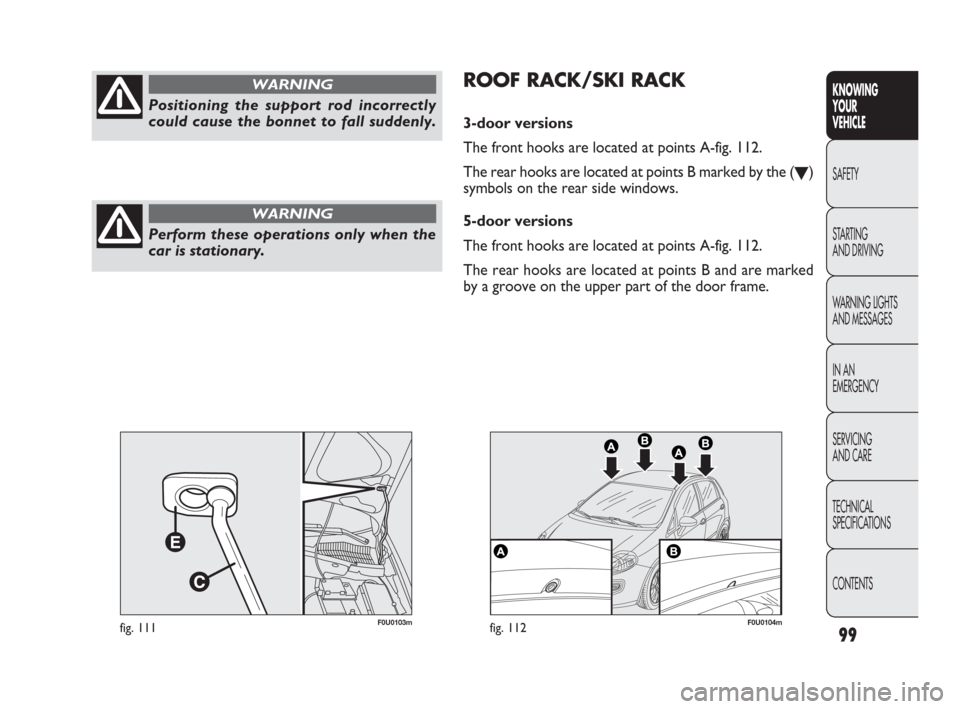
99
KNOWING
YOUR
VEHICLE
SAFETY
STARTING
AND DRIVING
WARNING LIGHTS
AND MESSAGES
IN AN
EMERGENCY
SERVICING
AND CARE
TECHNICAL
SPECIFICATIONS
CONTENTS
Positioning the support rod incorrectly
could cause the bonnet to fall suddenly.
WARNING
F0U0103mfig. 111
Perform these operations only when the
car is stationary.
WARNING
F0U0104mfig. 112
ROOF RACK/SKI RACK
3-door versions
The front hooks are located at points A-fig. 112.
The rear hooks are located at points B marked by the (
O)
symbols on the rear side windows.
5-door versions
The front hooks are located at points A-fig. 112.
The rear hooks are located at points B and are marked
by a groove on the upper part of the door frame.
082-128 PUNTO FL EN 4ed 20-01-2010 15:06 Pagina 99
Page 126 of 270
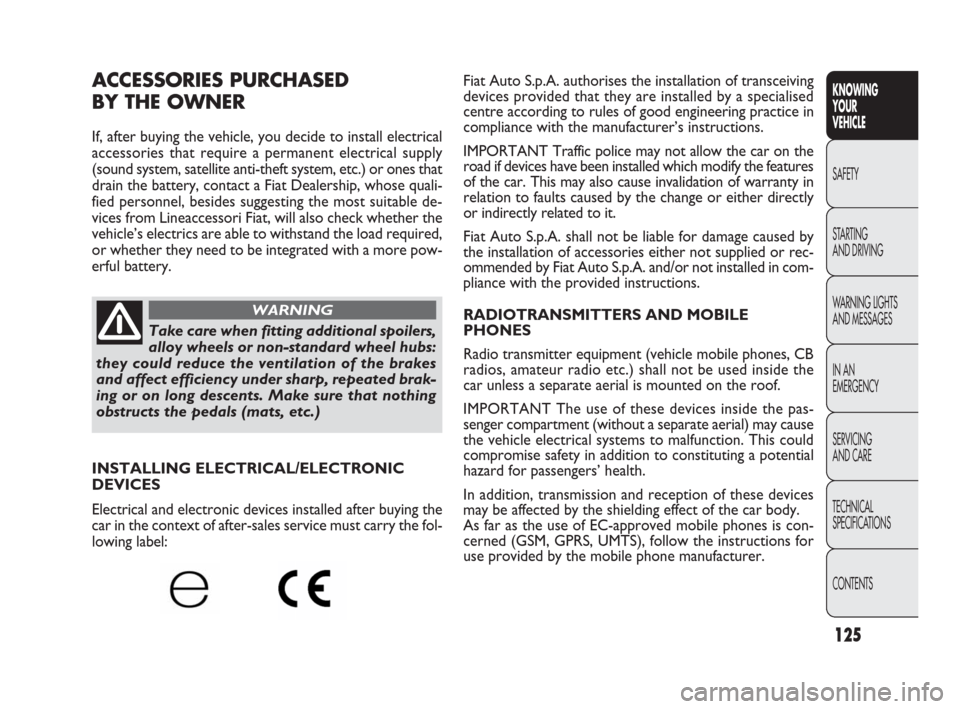
125
KNOWING
YOUR
VEHICLE
SAFETY
STARTING
AND DRIVING
WARNING LIGHTS
AND MESSAGES
IN AN
EMERGENCY
SERVICING
AND CARE
TECHNICAL
SPECIFICATIONS
CONTENTS
ACCESSORIES PURCHASED
BY THE OWNER
If, after buying the vehicle, you decide to install electrical
accessories that require a permanent electrical supply
(sound system, satellite anti-theft system, etc.) or ones that
drain the battery, contact a Fiat Dealership, whose quali-
fied personnel, besides suggesting the most suitable de-
vices from Lineaccessori Fiat, will also check whether the
vehicle’s electrics are able to withstand the load required,
or whether they need to be integrated with a more pow-
erful battery.
Take care when fitting additional spoilers,
alloy wheels or non-standard wheel hubs:
they could reduce the ventilation of the brakes
and affect efficiency under sharp, repeated brak-
ing or on long descents. Make sure that nothing
obstructs the pedals (mats, etc.)
WARNING
INSTALLING ELECTRICAL/ELECTRONIC
DEVICES
Electrical and electronic devices installed after buying the
car in the context of after-sales service must carry the fol-
lowing label:
Fiat Auto S.p.A. authorises the installation of transceiving
devices provided that they are installed by a specialised
centre according to rules of good engineering practice in
compliance with the manufacturer’s instructions.
IMPORTANT Traffic police may not allow the car on the
road if devices have been installed which modify the features
of the car. This may also cause invalidation of warranty in
relation to faults caused by the change or either directly
or indirectly related to it.
Fiat Auto S.p.A. shall not be liable for damage caused by
the installation of accessories either not supplied or rec-
ommended by Fiat Auto S.p.A. and/or not installed in com-
pliance with the provided instructions.
RADIOTRANSMITTERS AND MOBILE
PHONES
Radio transmitter equipment (vehicle mobile phones, CB
radios, amateur radio etc.) shall not be used inside the
car unless a separate aerial is mounted on the roof.
IMPORTANT The use of these devices inside the pas-
senger compartment (without a separate aerial) may cause
the vehicle electrical systems to malfunction. This could
compromise safety in addition to constituting a potential
hazard for passengers’ health.
In addition, transmission and reception of these devices
may be affected by the shielding effect of the car body.
As far as the use of EC-approved mobile phones is con-
cerned (GSM, GPRS, UMTS), follow the instructions for
use provided by the mobile phone manufacturer.
082-128 PUNTO FL EN 4ed 20-01-2010 15:07 Pagina 125
Page 146 of 270

145
KNOWING
YOUR
VEHICLE
SAFETY
STARTING
AND DRIVING
WARNING LIGHTS
AND MESSAGES
IN AN
EMERGENCY
SERVICING
AND CARE
TECHNICAL
SPECIFICATIONS
CONTENTS
WINDOW BAGS fig. 146
(for versions/markets where provided)
These consist of two “curtain” cushions, one on the right
and the other on the left side of the car, located behind
the side coverings of the roof and covered by appropri-
ate finishings.
Window bags have been designed for protecting the head
of front and rear occupants in the event of a side-on col-
lision, thanks to the wide cushion inflation surface.
F0U0127mfig. 145
SIDE BAGS fig. 145
(for versions/markets where provided)
Front side airbags are housed in the seat backrests. They
consist of an instant-inflation bag designed to increase pro-
tection of the occupants’ chest and pelvis zone in the event
of a side-on crash of medium/high severity.
F0U0128mfig. 146
129-148 PUNTO FL EN 4ed 18-01-2010 12:26 Pagina 145
Page 155 of 270
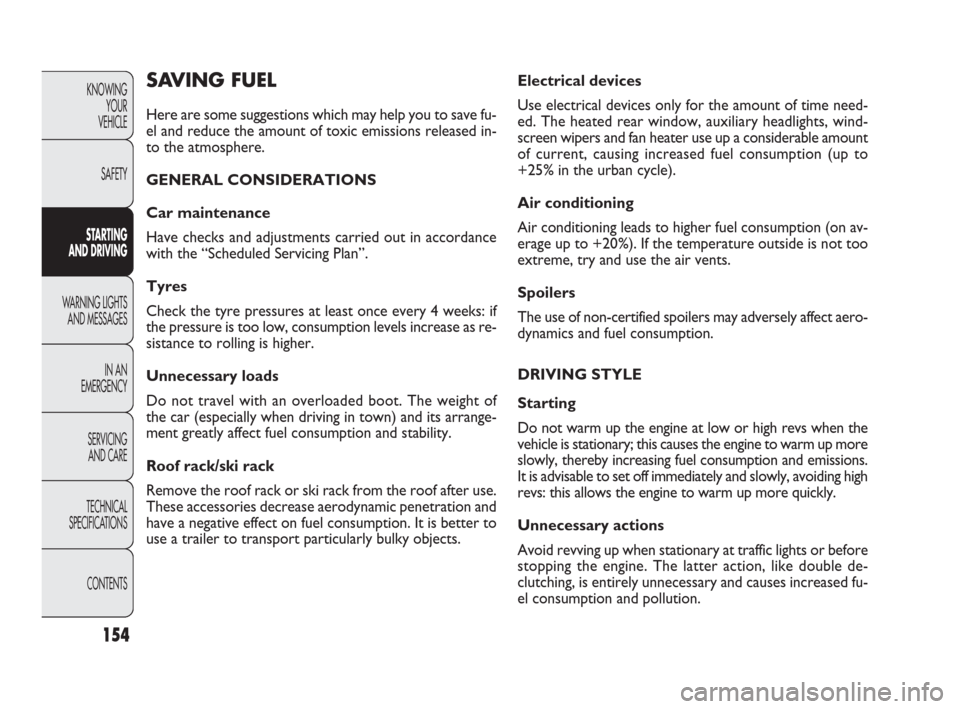
154
KNOWING
YOUR
VEHICLE
SAFETY
STARTING
AND DRIVING
WARNING LIGHTS
AND MESSAGES
IN AN
EMERGENCY
SERVICING
AND CARE
TECHNICAL
SPECIFICATIONS
CONTENTS
SAVING FUEL
Here are some suggestions which may help you to save fu-
el and reduce the amount of toxic emissions released in-
to the atmosphere.
GENERAL CONSIDERATIONS
Car maintenance
Have checks and adjustments carried out in accordance
with the “Scheduled Servicing Plan”.
Tyres
Check the tyre pressures at least once every 4 weeks: if
the pressure is too low, consumption levels increase as re-
sistance to rolling is higher.
Unnecessary loads
Do not travel with an overloaded boot. The weight of
the car (especially when driving in town) and its arrange-
ment greatly affect fuel consumption and stability.
Roof rack/ski rack
Remove the roof rack or ski rack from the roof after use.
These accessories decrease aerodynamic penetration and
have a negative effect on fuel consumption. It is better to
use a trailer to transport particularly bulky objects.Electrical devices
Use electrical devices only for the amount of time need-
ed. The heated rear window, auxiliary headlights, wind-
screen wipers and fan heater use up a considerable amount
of current, causing increased fuel consumption (up to
+25% in the urban cycle).
Air conditioning
Air conditioning leads to higher fuel consumption (on av-
erage up to +20%). If the temperature outside is not too
extreme, try and use the air vents.
Spoilers
The use of non-certified spoilers may adversely affect aero-
dynamics and fuel consumption.
DRIVING STYLE
Starting
Do not warm up the engine at low or high revs when the
vehicle is stationary; this causes the engine to warm up more
slowly, thereby increasing fuel consumption and emissions.
It is advisable to set off immediately and slowly, avoiding high
revs: this allows the engine to warm up more quickly.
Unnecessary actions
Avoid revving up when stationary at traffic lights or before
stopping the engine. The latter action, like double de-
clutching, is entirely unnecessary and causes increased fu-
el consumption and pollution.
149-160 PUNTO FL EN 4ed 20-01-2010 14:37 Pagina 154
Page 204 of 270

203
KNOWING
YOUR
VEHICLE
SAFETY
STARTING
AND DRIVING
WARNING LIGHTS
AND MESSAGES
IN AN
EMERGENCY
SERVICING
AND CARE
TECHNICAL
SPECIFICATIONS
CONTENTS
7.5
7.5
5
5
10
5
20
20
20
20
5
5
7.5 1
8
13
2
5
11
4
6
14
7
12
3
10
FUSE TABLE
Dashboard fuse box fig. 190
DEVICESFUSE AMPS
Right dipped beam headlight
Lift dipped beam headlight, headlamp alignment corrector
INT/A supply for switch coils on engine fuse box
and switch coils on body computer control unit
Front ceiling light, rear ceiling light, visor lights,
door marker lights, boot light, glove box light
Supply and battery for EOBD diagnostic plug, automatic climate
control system control unit, alarm, sound system, convergence control unit
INT supply for instrument panel, switch on brake pedal
(N.O. contact), third brake light
Door locking/unlocking motors, dead lock activation motors, boot
unlocking motor
Windscreen/rear window washer pump
Electric window motor on driver-side front door
Electric window motor on passenger-side front door
INT supply for dashboard control lights, parking control unit,
tyre pressure measurement control unit, electric wing mirror movement,
rain sensor, sunroof control unit, My Port infotelematic system socket,
electric rear view mirror
Instrument panel
INT supply for brake pedal switch (NC contact), clutch pedal switch,
interior heating unit, convergence control unit, sound system capabilities,
voltage stabiliser control unit, reverse light on rear bumper,
water sensor on diesel filter, glow plug heating control unit, airflow meter,
brake booster sensor, switch coils on engine compartment fuse box
175-210 PUNTO FL EN 4ed 20-01-2010 15:09 Pagina 203
Page 206 of 270

205
KNOWING
YOUR
VEHICLE
SAFETY
STARTING
AND DRIVING
WARNING LIGHTS
AND MESSAGES
IN AN
EMERGENCY
SERVICING
AND CARE
TECHNICAL
SPECIFICATIONS
CONTENTS
17
14
01
03
04
15
10
16
08
07
05
11
13
09
06
0220
7.5
–
–
10
–
20
–
10
–
15
20
5
10
–
– Boot fuse box fig. 194
DEVICESFUSE AMPS
Sunroof opening system
Alarm system management control unit
Spare
Spare
Electric lumbar movement on driver’s seat
Spare
Electric windows system (motor, control unit) on right-hand door
Spare
Driver’s seat heater control unit
Tow hook system (capability for after-sale fuse assembly)
Boot socket
Electric windows system (motor, control unit) on left-hand door
TPMS (tyre pressure monitoring system) control unit
Front passenger seat heater control unit
Spare
Spare
175-210 PUNTO FL EN 4ed 20-01-2010 15:10 Pagina 205
Page 233 of 270
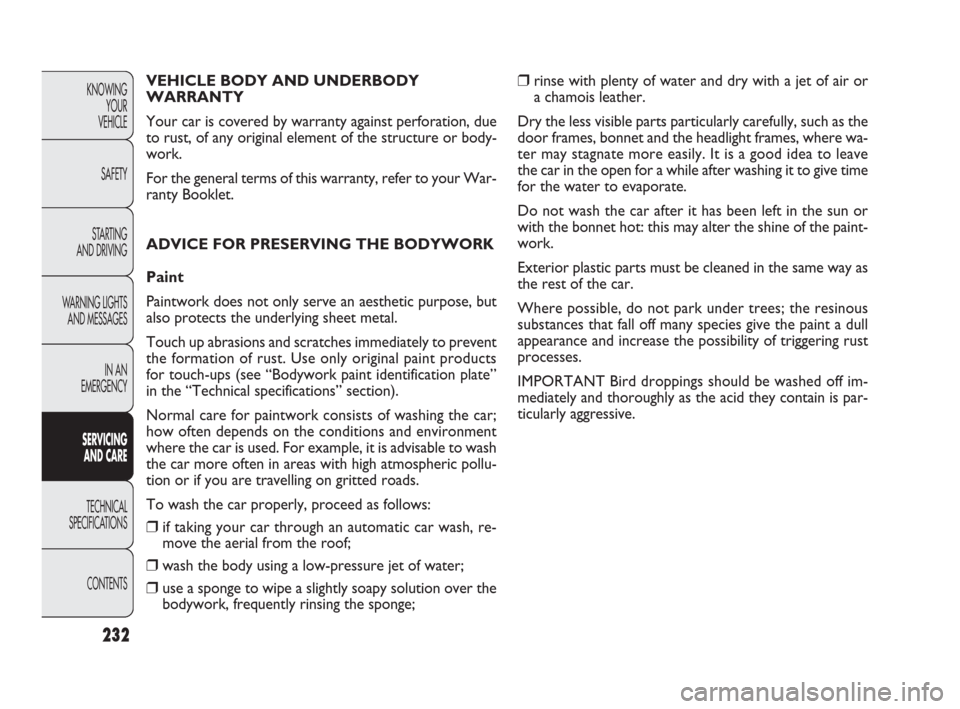
232
VEHICLE BODY AND UNDERBODY
WARRANTY
Your car is covered by warranty against perforation, due
to rust, of any original element of the structure or body-
work.
For the general terms of this warranty, refer to your War-
ranty Booklet.
ADVICE FOR PRESERVING THE BODYWORK
Paint
Paintwork does not only serve an aesthetic purpose, but
also protects the underlying sheet metal.
Touch up abrasions and scratches immediately to prevent
the formation of rust. Use only original paint products
for touch-ups (see “Bodywork paint identification plate”
in the “Technical specifications” section).
Normal care for paintwork consists of washing the car;
how often depends on the conditions and environment
where the car is used. For example, it is advisable to wash
the car more often in areas with high atmospheric pollu-
tion or if you are travelling on gritted roads.
To wash the car properly, proceed as follows:
❒if taking your car through an automatic car wash, re-
move the aerial from the roof;
❒wash the body using a low-pressure jet of water;
❒use a sponge to wipe a slightly soapy solution over the
bodywork, frequently rinsing the sponge;
KNOWING
YOUR
VEHICLE
SAFETY
STARTING
AND DRIVING
WARNING LIGHTS
AND MESSAGES
IN AN
EMERGENCY
SERVICING
AND CARE
TECHNICAL
SPECIFICATIONS
CONTENTS
❒rinse with plenty of water and dry with a jet of air or
a chamois leather.
Dry the less visible parts particularly carefully, such as the
door frames, bonnet and the headlight frames, where wa-
ter may stagnate more easily. It is a good idea to leave
the car in the open for a while after washing it to give time
for the water to evaporate.
Do not wash the car after it has been left in the sun or
with the bonnet hot: this may alter the shine of the paint-
work.
Exterior plastic parts must be cleaned in the same way as
the rest of the car.
Where possible, do not park under trees; the resinous
substances that fall off many species give the paint a dull
appearance and increase the possibility of triggering rust
processes.
IMPORTANT Bird droppings should be washed off im-
mediately and thoroughly as the acid they contain is par-
ticularly aggressive.
211-234 PUNTO FL EN 4ed 18-01-2010 12:28 Pagina 232